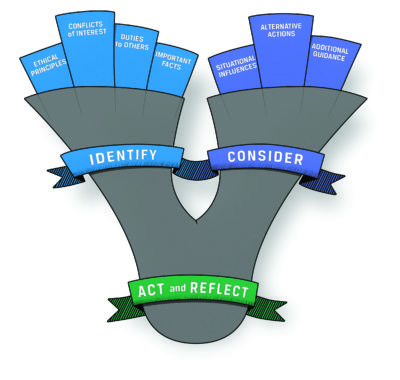Ethics in Practice: Buying and Selling at Same Time OK? Case for Week of 23 October
Analysis now posted below.
Ready for your weekly ethical workout? Keep Reading!
Case
Meyers Associates is an investment firm providing both advisory and investment banking services. One of Meyers investment banking clients, IWEB (which manufactures and markets data storage products and cloud based software), wants to raise its stock price to facilitate a private offering, for which it will be using Meyers as its placement agent. George works for Meyers Associates as an investment adviser. To assist IWEB with its plans, George solicits several of his advisory clients to buy IWEB stock, and at the same time solicits other clients to sell IWEB stock, frequently effecting matched orders among his customers. For a 10-day period, these trades represented 48% of the total market volume of IWEB, and the price of the stock increased from $0.12 to $0.19 and then stabilized at $0.18 for the next several days. George’s actions are
- acceptable if the purchase and sale of IWEB stock fit within each of his advisory clients’ Investment Policy Statements (IPS).
- acceptable because he was acting to promote the interests of his client, IWEB.
- acceptable as long as he discloses to his advisory clients Meyer Associates’ investment banking relationship with IWEB.
- unacceptable.
Analysis
This case is about market manipulation. Market manipulation damages the interests of all investors and lowers investor confidence in capital markets by disrupting the smooth functioning and efficiency of those markets. CFA Institute Standard II(B): Market Manipulation prohibits members from “engaging in practices that distort prices or artificially inflate trading volume with the intent to mislead market participants.” George’s trading of IWEB stock for clients is distorting both the trading volume and the market’s price-setting mechanism for that stock for the purpose of misleading investors in IWEB stock. George engages in the trading to assist IWEB with its private offering, not to benefit his advisory clients. Therefore, even if the trades fit within the respective IPS of his clients, the trading is unethical, making choice A incorrect. One element of the CFA Institute Ethical Decision-Making Framework is identifying to whom a duty is owed. Oftentimes, there are conflicting duties that must be sorted out. Although George is attempting to benefit one client (IWEB) through the trading, he cannot do so at the expense of his advisory clients because he has a duty to all his clients to treat them fairly. And although investment professionals have a duty to work on behalf of clients, they have a greater duty to protect the integrity of financial markets. Engaging in market manipulation, even to assist clients, is unethical, making choice B incorrect. Choice C is also incorrect. While oftentimes investment professionals can mitigate conflicts of interest through disclosure, disclosure of the potential conflict in working for IWEB in an investment banking capacity, does not allow George to use his advisory client accounts to engage in market manipulation. George’s actions are unacceptable, choice D. (This case is based on a Financial Industry Regulatory Authority (FINRA) enforcement case from 2016.)
Have an idea for a case for us to feature? Send it to us at [email protected].
More About the Ethics in Practice Series
Just as you need to practice to become proficient at playing a musical instrument, public speaking, or playing a sport, practicing assessing and analyzing situations and making ethical decisions develops your ethical decision-making skills. To promote “ethical exercise,” we are excited to introduce Ethics in Practice.
Each week, we will post a short vignette, drawn from real-world circumstances, regulatory cases, and CFA Institute Professional Conduct investigations, along with possible responses/actions. We then encourage you to assess the case through the lens of the Ethical Decision-Making Framework and the CFA Institute Code of Ethics and Standards of Professional Conduct and let us know which of the choices you believe is the right thing to do and why. If you are not a CFA Institute member, you can post your choice and reasoning in the comments section below. For CFA Institute members, we would like you to join the conversation in our new Member App and post your responses there. Later in the week, we will post an analysis of the case and you can see how your response compares.
CFA Institute Member App
The Member App gives CFA Institute members access to a content from multiple CFA Institute publications, including these weekly Ethics in Practice posts. Best of all, the app allows in-app submission of Continuing Education credits, which members can earn by reading and participating in the conversation for each case. (0.25 CE, 0.25 SER). The app is available in the Apple and Google Play stores. After downloading, simply log in using your CFA Institute website credentials (e.g., [email protected] + password). Hint: Save the post to your library in the app to find it easily.
If you liked this post, consider subscribing to Market Integrity Insights.
Image Credit: ©CFA Institute

